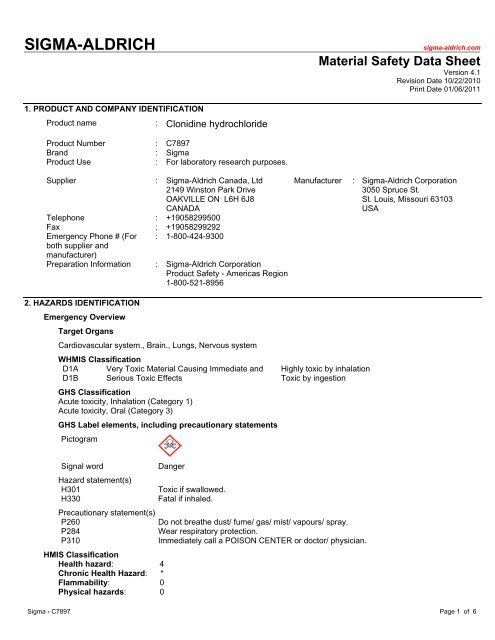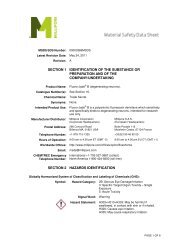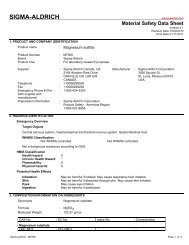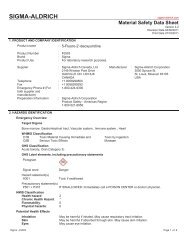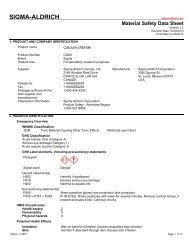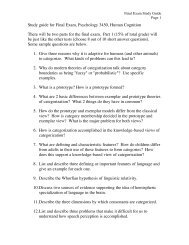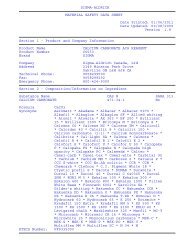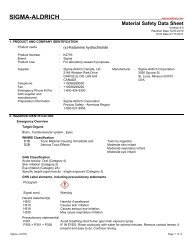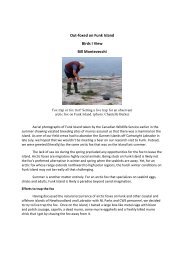Clonidine hydrochloride.pdf - Play Psych Mun
Clonidine hydrochloride.pdf - Play Psych Mun
Clonidine hydrochloride.pdf - Play Psych Mun
Create successful ePaper yourself
Turn your PDF publications into a flip-book with our unique Google optimized e-Paper software.
SIGMA-ALDRICH<br />
sigma-aldrich.com<br />
Material Safety Data Sheet<br />
Version 4.1<br />
Revision Date 10/22/2010<br />
Print Date 01/06/2011<br />
1. PRODUCT AND COMPANY IDENTIFICATION<br />
Product name : <strong>Clonidine</strong> <strong>hydrochloride</strong><br />
Product Number : C7897<br />
Brand : Sigma<br />
Product Use : For laboratory research purposes.<br />
Supplier : Sigma-Aldrich Canada, Ltd<br />
2149 Winston Park Drive<br />
OAKVILLE ON L6H 6J8<br />
CANADA<br />
Telephone : +19058299500<br />
Fax : +19058299292<br />
Emergency Phone # (For : 1-800-424-9300<br />
both supplier and<br />
manufacturer)<br />
Preparation Information : Sigma-Aldrich Corporation<br />
Product Safety - Americas Region<br />
1-800-521-8956<br />
Manufacturer<br />
: Sigma-Aldrich Corporation<br />
3050 Spruce St.<br />
St. Louis, Missouri 63103<br />
USA<br />
2. HAZARDS IDENTIFICATION<br />
Emergency Overview<br />
Target Organs<br />
Cardiovascular system., Brain., Lungs, Nervous system<br />
WHMIS Classification<br />
D1A Very Toxic Material Causing Immediate and<br />
D1B Serious Toxic Effects<br />
GHS Classification<br />
Acute toxicity, Inhalation (Category 1)<br />
Acute toxicity, Oral (Category 3)<br />
GHS Label elements, including precautionary statements<br />
Pictogram<br />
Highly toxic by inhalation<br />
Toxic by ingestion<br />
Signal word<br />
Hazard statement(s)<br />
H301<br />
H330<br />
Danger<br />
Toxic if swallowed.<br />
Fatal if inhaled.<br />
Precautionary statement(s)<br />
P260<br />
Do not breathe dust/ fume/ gas/ mist/ vapours/ spray.<br />
P284<br />
Wear respiratory protection.<br />
P310<br />
Immediately call a POISON CENTER or doctor/ physician.<br />
HMIS Classification<br />
Health hazard: 4<br />
Chronic Health Hazard: *<br />
Flammability: 0<br />
Physical hazards: 0<br />
Sigma - C7897 Page 1 of 6
Potential Health Effects<br />
Inhalation<br />
Skin<br />
Eyes<br />
Ingestion<br />
May be fatal if inhaled. May cause respiratory tract irritation.<br />
May be harmful if absorbed through skin. May cause skin irritation.<br />
May cause eye irritation.<br />
Toxic if swallowed.<br />
3. COMPOSITION/INFORMATION ON INGREDIENTS<br />
Synonyms : 2-(2,6-Dichloroanilino)-2-imidazoline<strong>hydrochloride</strong><br />
Formula : C 9 H 9 Cl 2 N 3 · HCl<br />
Molecular Weight : 266.55 g/mol<br />
CAS-No. EC-No. Index-No. Concentration<br />
<strong>Clonidine</strong> <strong>hydrochloride</strong><br />
4205-91-8 224-121-5 - -<br />
4. FIRST AID MEASURES<br />
General advice<br />
Consult a physician. Show this safety data sheet to the doctor in attendance.Move out of dangerous area.<br />
If inhaled<br />
If breathed in, move person into fresh air. If not breathing, give artificial respiration. Consult a physician.<br />
In case of skin contact<br />
Wash off with soap and plenty of water. Take victim immediately to hospital. Consult a physician.<br />
In case of eye contact<br />
Flush eyes with water as a precaution.<br />
If swallowed<br />
Never give anything by mouth to an unconscious person. Rinse mouth with water. Consult a physician.<br />
5. FIRE-FIGHTING MEASURES<br />
Conditions of flammability<br />
Not flammable or combustible.<br />
Suitable extinguishing media<br />
Use water spray, alcohol-resistant foam, dry chemical or carbon dioxide.<br />
Special protective equipment for fire-fighters<br />
Wear self contained breathing apparatus for fire fighting if necessary.<br />
Hazardous combustion products<br />
Hazardous decomposition products formed under fire conditions. - Carbon oxides, nitrogen oxides (NOx), Hydrogen<br />
chloride gas, Halogens<br />
Explosion data - sensitivity to mechanical impact<br />
no data available<br />
Explosion data - sensitivity to static discharge<br />
no data available<br />
6. ACCIDENTAL RELEASE MEASURES<br />
Personal precautions<br />
Wear respiratory protection. Avoid dust formation. Avoid breathing vapors, mist or gas. Ensure adequate ventilation.<br />
Evacuate personnel to safe areas. Avoid breathing dust.<br />
Environmental precautions<br />
Prevent further leakage or spillage if safe to do so. Do not let product enter drains.<br />
Sigma - C7897 Page 2 of 6
Methods and materials for containment and cleaning up<br />
Pick up and arrange disposal without creating dust. Sweep up and shovel. Keep in suitable, closed containers for<br />
disposal.<br />
7. HANDLING AND STORAGE<br />
Precautions for safe handling<br />
Avoid contact with skin and eyes. Avoid formation of dust and aerosols.<br />
Provide appropriate exhaust ventilation at places where dust is formed. Normal measures for preventive fire protection.<br />
Conditions for safe storage<br />
Keep container tightly closed in a dry and well-ventilated place.<br />
Recommended storage temperature: 2 - 8 °C<br />
8. EXPOSURE CONTROLS/PERSONAL PROTECTION<br />
Contains no substances with occupational exposure limit values.<br />
Personal protective equipment<br />
Respiratory protection<br />
Where risk assessment shows air-purifying respirators are appropriate use a full-face particle respirator type N100<br />
(US) or type P3 (EN 143) respirator cartridges as a backup to engineering controls. If the respirator is the sole<br />
means of protection, use a full-face supplied air respirator. Use respirators and components tested and approved<br />
under appropriate government standards such as NIOSH (US) or CEN (EU).<br />
Hand protection<br />
Handle with gloves. Gloves must be inspected prior to use. Use proper glove removal technique (without touching<br />
glove's outer surface) to avoid skin contact with this product. Dispose of contaminated gloves after use in<br />
accordance with applicable laws and good laboratory practices. Wash and dry hands.<br />
Eye protection<br />
Face shield and safety glasses Use equipment for eye protection tested and approved under appropriate<br />
government standards such as NIOSH (US) or EN 166(EU).<br />
Skin and body protection<br />
Complete suit protecting against chemicals, The type of protective equipment must be selected according to the<br />
concentration and amount of the dangerous substance at the specific workplace.<br />
Hygiene measures<br />
Avoid contact with skin, eyes and clothing. Wash hands before breaks and immediately after handling the product.<br />
Specific engineering controls<br />
Use mechanical exhaust or laboratory fumehood to avoid exposure.<br />
9. PHYSICAL AND CHEMICAL PROPERTIES<br />
Appearance<br />
Form<br />
solid<br />
Colour<br />
Safety data<br />
pH<br />
Melting/freezing<br />
point<br />
Boiling point<br />
Flash point<br />
Ignition temperature<br />
Autoignition<br />
temperature<br />
white<br />
no data available<br />
130 °C (266 °F)<br />
no data available<br />
no data available<br />
no data available<br />
no data available<br />
Sigma - C7897 Page 3 of 6
Lower explosion limit<br />
Upper explosion limit<br />
Vapour pressure<br />
Density<br />
Water solubility<br />
Partition coefficient:<br />
n-octanol/water<br />
Relative vapour<br />
density<br />
Odour<br />
Odour Threshold<br />
Evaporation rate<br />
no data available<br />
no data available<br />
no data available<br />
no data available<br />
ca.50 g/l<br />
no data available<br />
no data available<br />
no data available<br />
no data available<br />
no data available<br />
10. STABILITY AND REACTIVITY<br />
Chemical stability<br />
Stable under recommended storage conditions.<br />
Possibility of hazardous reactions<br />
no data available<br />
Conditions to avoid<br />
no data available<br />
Materials to avoid<br />
Strong oxidizing agents<br />
Hazardous decomposition products<br />
Hazardous decomposition products formed under fire conditions. - Carbon oxides, nitrogen oxides (NOx), Hydrogen<br />
chloride gas, Halogens<br />
11. TOXICOLOGICAL INFORMATION<br />
Acute toxicity<br />
Oral LD50<br />
LD50 Oral - rat - 126 mg/kg<br />
Remarks: Behavioral:Somnolence (general depressed activity). Behavioral:Ataxia. Skin and Appendages: Other: Hair.<br />
Inhalation LC50<br />
LC50 Inhalation - rat - 4 h - 19.7 mg/m3<br />
Remarks: Behavioral:Tremor. Behavioral:Aggression. Lungs, Thorax, or Respiration:Dyspnea.<br />
Dermal LD50<br />
no data available<br />
Other information on acute toxicity<br />
no data available<br />
Skin corrosion/irritation<br />
no data available<br />
Serious eye damage/eye irritation<br />
no data available<br />
Respiratory or skin sensitization<br />
no data available<br />
Germ cell mutagenicity<br />
no data available<br />
Carcinogenicity<br />
Sigma - C7897 Page 4 of 6
IARC: No component of this product present at levels greater than or equal to 0.1% is identified as probable,<br />
possible or confirmed human carcinogen by IARC.<br />
ACGIH: No component of this product present at levels greater than or equal to 0.1% is identified as a<br />
carcinogen or potential carcinogen by ACGIH.<br />
Reproductive toxicity<br />
Reproductive toxicity - rat - Oral<br />
Maternal Effects: Ovaries, fallopian tubes.<br />
Reproductive toxicity - Mammal - Subcutaneous<br />
Effects on Newborn: Growth statistics (e.g., reduced weight gain).<br />
no data available<br />
Teratogenicity<br />
Developmental Toxicity - Domestic Animals - Intravenous<br />
Specific Developmental Abnormalities: Cardiovascular (circulatory) system.<br />
no data available<br />
Specific target organ toxicity - single exposure (Globally Harmonized System)<br />
no data available<br />
Specific target organ toxicity - repeated exposure (Globally Harmonized System)<br />
no data available<br />
Aspiration hazard<br />
no data available<br />
Potential health effects<br />
Inhalation<br />
May be fatal if inhaled. May cause respiratory tract irritation.<br />
Ingestion<br />
Toxic if swallowed.<br />
Skin<br />
May be harmful if absorbed through skin. May cause skin irritation.<br />
Eyes<br />
May cause eye irritation.<br />
Signs and Symptoms of Exposure<br />
To the best of our knowledge, the chemical, physical, and toxicological properties have not been thoroughly investigated.<br />
Synergistic effects<br />
no data available<br />
Additional Information<br />
RTECS: NJ2490000<br />
12. ECOLOGICAL INFORMATION<br />
Toxicity<br />
no data available<br />
Persistence and degradability<br />
no data available<br />
Bioaccumulative potential<br />
no data available<br />
Mobility in soil<br />
no data available<br />
PBT and vPvB assessment<br />
no data available<br />
Other adverse effects<br />
no data available<br />
Sigma - C7897 Page 5 of 6
13. DISPOSAL CONSIDERATIONS<br />
Product<br />
Offer surplus and non-recyclable solutions to a licensed disposal company. Contact a licensed professional waste<br />
disposal service to dispose of this material. Dissolve or mix the material with a combustible solvent and burn in a<br />
chemical incinerator equipped with an afterburner and scrubber.<br />
Contaminated packaging<br />
Dispose of as unused product.<br />
14. TRANSPORT INFORMATION<br />
DOT (US)<br />
UN-Number: 2811 Class: 6.1<br />
Packing group: I<br />
Proper shipping name: Toxic solids, organic, n.o.s. (<strong>Clonidine</strong> <strong>hydrochloride</strong>)<br />
Marine pollutant: No<br />
Poison Inhalation Hazard: No<br />
IMDG<br />
UN-Number: 2811 Class: 6.1 Packing group: I EMS-No: F-A, S-A<br />
Proper shipping name: TOXIC SOLID, ORGANIC, N.O.S. (<strong>Clonidine</strong> <strong>hydrochloride</strong>)<br />
Marine pollutant: No<br />
IATA<br />
UN-Number: 2811 Class: 6.1<br />
Packing group: I<br />
Proper shipping name: Toxic solid, organic, n.o.s. (<strong>Clonidine</strong> <strong>hydrochloride</strong>)<br />
IATA Passenger: Not permitted for transport<br />
15. REGULATORY INFORMATION<br />
DSL Status<br />
All components of this product are on the Canadian DSL list.<br />
WHMIS Classification<br />
D1A Very Toxic Material Causing Immediate and<br />
D1B Serious Toxic Effects<br />
Highly toxic by inhalation<br />
Toxic by ingestion<br />
This product has been classified in accordance with the hazard criteria of the Controlled Products Regulations and the<br />
MSDS contains all the information required by the Controlled Products Regulations.<br />
16. OTHER INFORMATION<br />
Further information<br />
Copyright 2010 Sigma-Aldrich Co. License granted to make unlimited paper copies for internal use only.<br />
The above information is believed to be correct but does not purport to be all inclusive and shall be used only as a<br />
guide. The information in this document is based on the present state of our knowledge and is applicable to the<br />
product with regard to appropriate safety precautions. It does not represent any guarantee of the properties of the<br />
product. Sigma-Aldrich Co., shall not be held liable for any damage resulting from handling or from contact with the<br />
above product. See reverse side of invoice or packing slip for additional terms and conditions of sale.<br />
Sigma - C7897 Page 6 of 6


